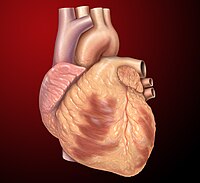
Photo from wikipedia
A 50-year old man with a structurally normal heart presented with recurrent palpitations for six months. This was in spite of a recent radiofrequency ablation at another center for a… Click to show full abstract
A 50-year old man with a structurally normal heart presented with recurrent palpitations for six months. This was in spite of a recent radiofrequency ablation at another center for a presumed diagnosis of atrio-ventricular nodal reentrant tachycardia (AVNRT). Interestingly, his first radiofrequency ablation for a tachyarrhythmia was over a decade ago, but records were unavailable. The 12 lead Electrocardiogram (ECG) revealed a short RP tachycardia at rate of 170 bpm. There was no preexcitation during sinus rhythm. Baseline intervals were normal during the ensuing electrophysiology study (EPS). The catheter positions with the annotations His (His bundle), CS (coronary sinus; proximal bipole 9-10 at CS ostium and distal bipole 1-2) and RV (right ventricle apex) are self-explanatory. A regular narrow complex tachycardia with rate related right bundle branch block (CL 280-340 ms, shortest VA 90 ms, and AH 165 ms) was reproducibly induced with a single atrial extra stimulus test (AEST) (Figure 1a). The response to maneuvers performed during tachycardia are denoted: i.e. right ventricular overdrive pacing (VOP) (Figure 1b), His refractory ventricular extra stimulus (HRVES) from the RV (Figure 1c), as well the left ventricular (LV) apex via the radiofrequency ablation catheter (RF 1-2, Figure 1d). What can be deciphered as the mechanism of this tachycardia? This article is protected by copyright. All rights reserved.
Journal Title: Journal of Cardiovascular Electrophysiology
Year Published: 2023
Link to full text (if available)
Share on Social Media: Sign Up to like & get
recommendations!